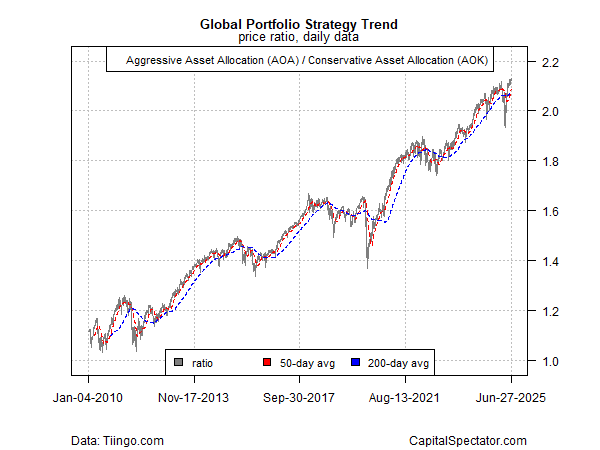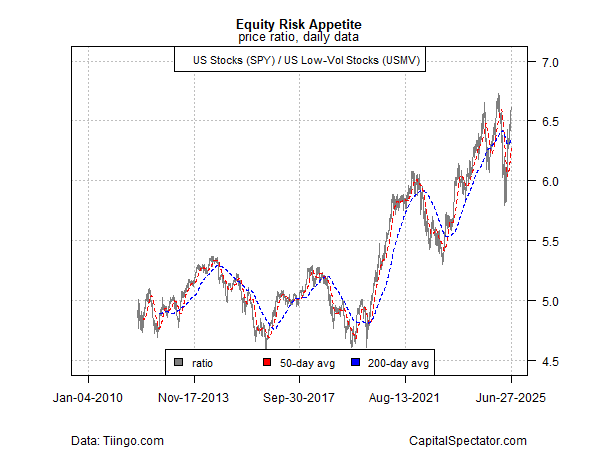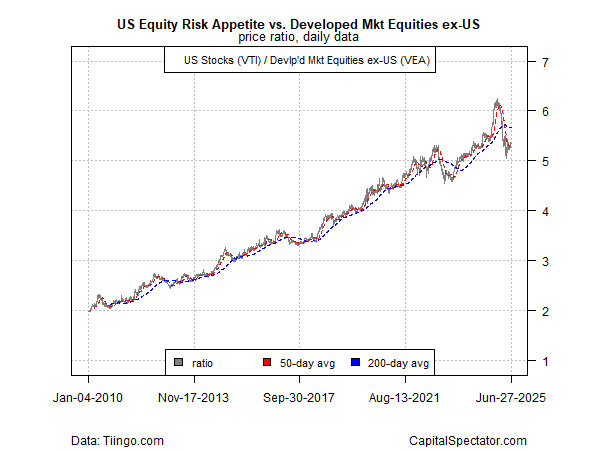U.S. stocks edge higher after weekly jobless claims; Salesforce gains
For a brief few weeks it looked like the jig was up. But the selling wave has all but faded as sentiment has recovered and markets have rebounded from the perspective of a high-level global asset allocation perspective. Reviewing a select set of proxy ETFs suggests that risk-on sentiment has returned for the strategic outlook, based on prices through Friday’s close (June 27).
There’s room for debate about whether risk-on signaling ever faded vis-a-vis globally diversified portfolios. As noted in recent weeks in our sister publication – The ETF Portfolio Strategist – a long-term measure of the trend for a set of global asset allocation ETFs never faltered during the recent turmoil and remained risk-on throughout. By comparison, the short- and medium-term indicators switched to risk-off early on in the selling. The lesson: Investors with a sufficiently long time horizon, and the wherewithal to look through the recent market volatility, have been rewarded by downplaying the headlines du jour.
A proxy for global asset allocation is back to a robust risk-on posture, according to the ratio for an aggressive strategy (AOA) vs. its conservative counterpart (AOK).
Drilling down into specific asset classes, on the other hand, paints more of a mixed picture. Although the US stock market (S&P 500) closed at a new record high on Friday, a measure of risk appetite via an S&P 500 ETF (SPY) vs. its low-volatility counterpart (USMV) has yet to fully recover from the April selloff.

Meanwhile, the weakness in US stocks (VTI) relative to foreign equities in developed markets (VEA) persists.

The same story applies for US stocks (VTI) vs. equities in emerging markets (VWO).

One trend that remains mostly unaffected this year is the relative weakness for US small caps (IJR) vs. their large-cap brethren (SPY).

Note, too, that the ratio of US stocks (SPY) to bonds (BND) remains in a grey area. The 50-day average for this ratio has rebounded, but has yet to return to a full-out risk-on posture by rising above its 200-day counterpart. A sign of lingering caution?

The main takeaway from these charts is that while risk-on looks strong once more from a global asset allocation view, the trends are still muddled for US assets. Factors for why that’s so include ongoing uncertainty about the outlook for the Federal Reserve’s monetary policy, tariffs, and the inflation implications of the spending bill that’s currently working its way through the Senate. US market sentiment is increasingly shrugging off these risks, but has yet to go all-in on a risk-on posture. Will this be the week that the crowd returns to the bullish fold with no reservations?
